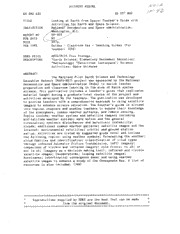
NASA Technical Reports Server (NTRS) 19960050448: Looking at Earth from Space: Teacher's Guide with Activities for Earth and Space Science PDF
Preview NASA Technical Reports Server (NTRS) 19960050448: Looking at Earth from Space: Teacher's Guide with Activities for Earth and Space Science
DOCUMENT RESUME ED 392 630 SE 057 860 TITLE Looking at Earth from Space: Teacher's Guide with Activities for Earth and Space Science. INSTITUTION N_o_autics and Space Administration, _W'a sh ingt on ,jD. C. REPORT NO f EP-303 PUB DATE NOTE PUB TYPE Guides - Classroom Use - Teaching Guides (For Teacher) (052) EDRS PRICE MF01/PC15 Plus Postage. DESCRIPTORS *Earth Science; Elementary Secondary Education; *Meteorology; *Satellites (Aerospace); Science Activities; Space Sciences ABSTRACT The Maryland Pilot Earth Science and Technology Education Network (MAPS-NET) project was sponsored by the National Aeronautics and Space Administration (NASA) to enrich teacher preparation and classroom learning in the area of Earth system science. This publication includes a teacher's guide that replicates material taught during a graduate-level course of the project and activities developed by the teachers. The publication was developed to provide teachers with a comprehensive approach to using satellite imagery to enhance science education. The teacher's guide is divided into topical chapters and enables teachers to expand their knowledge of the atmosphere, common weather patterns, and remote sensing. Topics include: weather systems and satellite imagery including mld-latitude weather systems; wave motion and the general circulation; cyclonic disturbances and baroclinlc instability; clouds; additional common weather patterns; satellite images and the internet; environmental satellites; orbits; and ground station set-up. Activities are listed by suggested grade level and include the following topics: using weather symbols; forecasting the weather; cloud families and identification; classification of cloud types through infrared Automatic Picture Transmission, (APT) imagery; comparison of visible and infrared imagery; cold fronts; to ski or not to ski (imagery as a decision making tool), infrared and visible satellite images; thunderstorms; looping satellite images; hurricanes; intertropical convergence zone; and using weather satellite images to enhance a study of the Chesapeake Bay. A list of resources is also included. (JRH) * Reproductions supplied by EDRS are the best that can be made * * from the original document. * *************** ******************** ****** ******* * * * *** *****************
